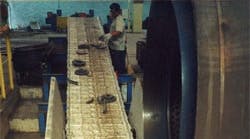Higher volume production may create a “bottleneck” at the cleaning and finishing stage for many foundries, but several of them have effectively addressed these tie-ups by updating the shakeout system. “Carryover” sand, as well as the sand adhering to the castings, is the largest component to shot-blasting costs: labor, shot consumption, energy consumption, replacement wear parts, and maintenance time, all are increased by the presence of sand in the system. By preventing the sand from going into the casting cleaning department, and keeping it in the sand system where it belongs, the benefits go right to the bottom line.
Other advantages include reduced wear for dust collectors, fewer waste streams, no airborne silica dust, and less clean-up time. When the castings are pre-cleaned in the shakeout system, the cleaning/finishing bottleneck is eliminated. Couple the pre-cleaning with casting cooling, and the production flow is streamlined.
Having cleaned gates, runners, and sprue transported from the shakeout department directly to the melting department will relieve the bottleneck in the cleaning department. If the gates, runners, and sprue are too much to shot-blast away, then the melting department faces excessive slag buildup, reduced furnace lining life, and lower melting efficiency. The savings for the melting department may justify the need to have clean returns sent directly from the shakeout department. Cleaner melting, finishing, and shakeout areas all add up to a better and safer workplace.
Saint-Gobain Pipelines’ Sinclair Works in Telford, England, improved its shakeout and finishing operations by installing a Didion rotary media drum to eliminate shot blasting altogether. The Mark 5 rotary media drum processes sand and castings from a DISA vertically parted molding line.
Sand is separated from the castings and then screened twice to -9 mm in the Didion. All the metallics are thoroughly cleaned by a recirculating bed of prismatoid media, which also protects and cools the castings. Upon discharging from the Didion, the castings are submerged into a water quench for final cooling. The clean and cooled castings are conveyed to grinding stations, and the clean gates, runners, and sprue are sent directly to the melting department.
This streamlined approach has been so successful that Sinclair Works ordered the latest Didion Mark 5 Series rotary media drum. The new Mark 5 is more robust than previous designs, with new features like external sand screening, automatic chain tensioner, split pillow block design with quick change bearing inserts, duplex chain, thicker liners with contoured rifling, cast-in dam retention rings, and a self-relieving tapered media separation chamber for fragile castings.
Combining sand casting separation, dualsand screening, and casting cleaning and cooling has proven so successful that paybacks are calculated in 4-5 months. The foundry also has less capital equipment to purchase, install, and maintain. Less equipment means less dust collection requirements and less daily energy consumption.
Currently, Didion International has installed the new Mark 5 Series rotary media drum at foundries in 48 countries. The machines are custom designed to handle aluminum, brass, bronze, ductile, grey, and steel castings. Green sand, shell, lost foam, and no-bake foundries have all benefited from this patented approach.
United Machine & Foundry in Winona, MN, installed a new Didion Mark 5 Series machine, too. “With the installation of our new MK5 rotary media drum we have improved three facets of the UMF operation – safety, quality, and productivity,” explained UMF director of operations Steve Renk. “The Didion gives us an advantage over competitors,” he said.
“Prior to installing our new equipment, we operated a vibratory shakeout system,” Renk continued. “A man running this piece of equipment was pretty much sentenced to work in hell: We lost a number of employees over the years because the job was just too barbaric. Standing over a vibrating shakeout, trying to hook castings and place them in tote boxes is difficult and it is compounded by dust, steam, and heat. By installing the Mark 5, we have eliminated a safety hazard.”
Noting the quality improvements that UMF has realized, Renk explained that “the rotary media drum’s ability to blend hot and cool sand has also benefited our sand system. With the vibratory shakeout, the sand storage system had layers of hot sand on top of layers of cool sand, making the compactability of the sand difficult to control. The new system has helped to reduce big swings in sand temperatures, thus allowing our compactability controller to run much more efficiently,” he said.
“Productivity gains and reduced costs have proven to be an added bonus,” Renk continued. “Many of the castings that we produce are no longer shot-blast. UMF has reduced the man-hours in shot-blasting and reduced operating hours on the maintenanceintensive shot-blast machines, which has allowed us to use production and maintenance personnel more effectively. We have significant annual savings from reductions in labor, sand disposal costs, shot purchases, accidents, and maintenance/repair costs.”











